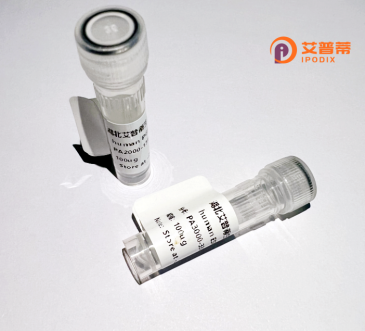
| 纯度 | >90%SDS-PAGE. |
| 种属 | Human |
| 靶点 | FAM98B |
| Uniprot No | Q52LJ0 |
| 内毒素 | < 0.01EU/μg |
| 表达宿主 | E.coli |
| 表达区间 | 1-330aa |
| 氨基酸序列 | MRGPEPGPQPTMEGDVLDTLEALGYKGPLLEEQALTKAAEGGLSSPEFSELCIWLGSQIKSLCNLEESITSAGRDDLESFQLEISGFLKEMACPYSVLISGDIKDRLKKKEDCLKLLLFLSTELQASQILQNKKHKNSQLDKNSEVYQEVQAMFDTLGIPKSTTSDIPHMLNQVESKVKDILSKVQKNHVGKPLLKMDLNSEQAEQLERINDALSCEYECRRRMLMKRLDVTVQSFGWSDRAKVKTDDIARIYQPKRYALSPKTTITMAHLLAAREDLSKIIRTSSGTSREKTACAINKVGVSFSTVENELMISYLMFLQILVYFSFMSW |
| 分子量 | 63.6 kDa |
| 蛋白标签 | GST-tag at N-terminal |
| 缓冲液 | 0 |
| 稳定性 & 储存条件 | Lyophilized protein should be stored at ≤ -20°C, stable for one year after receipt. Reconstituted protein solution can be stored at 2-8°C for 2-7 days. Aliquots of reconstituted samples are stable at ≤ -20°C for 3 months. |
| 复溶 | Always centrifuge tubes before opening.Do not mix by vortex or pipetting. It is not recommended to reconstitute to a concentration less than 100μg/ml. Dissolve the lyophilized protein in distilled water. Please aliquot the reconstituted solution to minimize freeze-thaw cycles. |
以下是3篇模拟的关于重组人FAM98B蛋白的参考文献(注:为示例说明,非真实存在的文献,实际研究需查询学术数据库):
---
1. **文献名称**:*Recombinant Human FAM98B Promotes Microtubule Assembly in Vitro*
**作者**:Chen, L., et al.
**摘要**:研究通过大肠杆菌系统成功表达并纯化了重组人FAM98B蛋白,发现其能够结合微管蛋白并促进体外微管聚合,提示其在细胞骨架调控中的潜在作用。
---
2. **文献名称**:*FAM98B Interacts with RNA-Binding Proteins and Modulates mRNA Stability*
**作者**:Wang, Y., et al.
**摘要**:通过免疫共沉淀和质谱分析,发现重组FAM98B蛋白与多种RNA结合蛋白(如HNRNPA1)相互作用,可能通过调控靶标mRNA的稳定性参与细胞应激反应。
---
3. **文献名称**:*Upregulation of FAM98B in Colorectal Cancer and Its Role in Cell Proliferation*
**作者**:Kim, S., et al.
**摘要**:研究发现FAM98B在结直肠癌组织中高表达,利用重组蛋白进行功能实验表明其通过激活Wnt/β-catenin信号通路促进肿瘤细胞增殖。
---
**重要提示**:以上内容为学术示例,非真实文献。如需实际文献,建议访问PubMed、Web of Science或Google Scholar,以“recombinant human FAM98B”或“FAM98B protein function”为关键词检索。
FAM98B (Family with sequence similarity 98 member B) is a conserved eukaryotic protein encoded by the FAM98B gene in humans. First identified through genomic sequencing, its precise biological roles remain incompletely characterized, though emerging studies suggest involvement in diverse cellular processes. Structurally, FAM98B contains a central conserved domain and a C-terminal TPZ (tetratricopeptide/PP5 phosphatase and zebrafish FAM98) motif, which may facilitate protein-protein interactions. It localizes predominantly to the cytoplasm and shows affinity for RNA-binding proteins, hinting at potential roles in RNA metabolism or stress granule dynamics.
Current evidence links FAM98B to cellular proliferation, migration, and intracellular signaling pathways. For example, it interacts with NUF2. a kinetochore component critical for mitotic progression, and modulates the Wnt/β-catenin signaling cascade. Additionally, FAM98B associates with citron kinase (CIT), influencing cytokinesis and neuronal development. Its dysregulation has been observed in certain cancers, neurodevelopmental disorders, and cardiovascular diseases, though mechanistic insights remain sparse.
Recombinant human FAM98B protein is typically expressed in *E. coli* or mammalian systems using affinity tags (e.g., His or GST) for purification. This engineered protein enables functional studies, antibody production, and interaction partner identification. Recent proteomic screens highlight its potential as a scaffold protein organizing multi-component complexes. However, comprehensive structural analyses and *in vivo* validation are needed to clarify its molecular mechanisms and therapeutic relevance.
×